
Hal Finney, a computer scientist and the world’s first publicly known Bitcoiner, would have celebrated his 66th birthday today.
Finney was also the first person to publicly run Bitcoin (BTC), going down in the annals of crypto Twitter history with a famous tweet that often resurfaces:
Raise a glass to the world’s first Bitcoiner today. Hal Finney, the first person to receive a Bitcoin transaction from none other than Satoshi Nakamoto would have celebrated his birthday today.
Running bitcoin
— halfin (@halfin) January 11, 2009
On Bitcointalk.org, Hal Finney explained that when Satoshi first released the software, he “grabbed it right away.”
“I think I was the first person besides Satoshi to run bitcoin. I mined block 70-something, and I was the recipient of the first bitcoin transaction, when Satoshi sent ten coins to me as a test.”
The wallet address for the 10 Bitcoin transaction tells a story: surging to 10 Bitcoin in value in 2009 (roughly $400,000 in today’s terms), but before Bitcoin had a dollar-denominated value.

For Pete Rizzo, editor at Kraken and Bitcoin magazine, Finney was a “visionary”:
✨ Today is Hal Finney’s 66th birthday. RIP to a true legend — the recipient of the first #Bitcoin transaction and a visionary who embraced its invention when others wouldn’t dare pic.twitter.com/rKNJ0m3ftI
— RIZZO (@pete_rizzo_) May 4, 2022
Finney sadly passed away from Amyotrophic lateral sclerosis (ALS), also known as motor neuron disease, in Phoenix in 2014. However, an eternal technologist, he was cryopreserved by the Alcor Life Extension Foundation and may be brought back to life via a technological medium in the future.
Prior to the diagnosis of the debilitating illness, Finney was known for more than just running Bitcoin: he ran half-marathons up until September 6th, 2009.
Happy Birthday to the one and only Hal Finney!!
— PU₿LORD (@publordhodl) May 4, 2022
Your spirit shall always live on...@halfin@franfinney pic.twitter.com/GHkODO8sqM
As a part of his legacy, many Bitcoin foundations and charities organize running events including “Running Bitcoin” to fight ALS.
Related: ‘How I met Satoshi’: The mission to teach 100M people about Bitcoin by 2030
For some Bitcoin supporters, it’s a time to look back on his life and celebrate his achievements. But in typical Bitcoin Twitter fashion, it’s also an opportunity to make light of the situation:
Just imagine what we could have done with a Full Inney
— Bitcoin Lebowski (@DudeJLebowski) May 4, 2022














